
Ann Arbor, Michigan





Ann Arbor, Michigan



ALINA LEVINE Daily Sports Editor
When the No. 20 Michigan football team took the field Saturday, it knew its offense was bound to run into struggles. For a team that prides itself on a “smash” philosophy, the Wolverines found themselves toeto-toe with Wisconsin, a team that, entering the matchup, boasted the best run defense in the country.
As expected, despite scoring on its first drive, Michigan’s offense ran cold for most of the first half of the game. Its possessions were marred by incomplete passes and promising drives that ultimately ended in punts. But thanks to a second-half offensive push, catalyzed by diverse third-quarter plays, the Wolverines (4-1 overall, 2-0 Big Ten) managed to churn out a win over the Badgers (2-3, 0-2), 24-10. When the Wolverines first took
the field, it looked like an entirely different ballgame than what ultimately shaped up to be a twotouchdown game.
After Wisconsin running back Dilin Jones ran it into the end zone on the Badgers’ first drive for an early lead, Michigan retaliated almost immediately. Ripping off a 43-yard run into Badgers territory, junior running back Justice Haynes put the Wolverines within 5 yards of a touchdown on their respective
Wolverines’ run game stifled, freshman quarterback Bryce Underwood’s 4-for-7 completion tally midway through the second quarter simply wasn’t enough to generate any significant offensive momentum. The only points that Michigan managed to put up for the remainder of the half came from a 40-yard field goal scored by senior kicker Dominic Zvada.
“They have a great defense,” Underwood said. “We try
Wolverines still had plenty of time to try and take control of the game. And who better to galvanize the offense than Michigan’s No. 1 receiver, graduate wide receiver Donaven McCulley.
5:14 left in the third quarter remained when Underwood scanned downfield, searching for a target. He suddenly spotted McCulley sprinting down the left sideline with a defender hot on his tail, and Underwood decided
that moment when the Wolverines, invigorated by McCulley’s play, began to push back. And just one play later, McCulley caught a short pass up the middle and weaved through a maze of defenders for Michigan’s second touchdown of the game and the first of his career.
“I was just hungry for the touchdown,” McCulley said.
“That’s just what type of player I am. I want to get in that end zone.” For as much as McCulley was
catalyst came in the form of Haynes. Two strong rushes from Haynes and a 25-yard catch by McCulley later, and Michigan once again found itself on the doorstep of the Badgers’ end zone. Driving forward through the dogpile, Haynes successfully bulldozed his way into the end zone for his second and the Wolverines’ final touchdown of the game. Against Wisconsin, Michigan’s



Follow The Daily
Climate reporter Bill Spindle shares insights about reporting in global energy battlegrounds The
AVA PUSTULKA Daily Staff Reporter
The University of Michigan’s School for Environment and Sustainability and the William Davidson Institute hosted a discussion by Bill Spindle, energy transition and global climate correspondent, on his career reporting as an environmental journalist across the world Wednesday afternoon. A part of the University’s first annual Climate Week, the event highlighted the intersection of journalism, global politics and the challenges of a transition to clean energy.
Spindle, who graduated from the University with a degree in English literature, has reported on climate politics for decades. Previously, he worked as a reporter and The Wall Street Journal’s bureau chief for countries in the Middle East, Asia and Africa, where he covered topics including India’s water crisis and the United Nations climate conferences.
Spindle currently works as an independent journalist.
At the beginning of the event, Spindle said while the process of fighting climate change is difficult, he believes pathways will continue to open for the U.S. to develop sustainable energy practices.
“How are we going to grow the energy system, meet all this demand, do all these things we want and, at the same time, get the carbon emissions under control and then begin pushing them forward?” Spindle said.
“The good news is there’s lots more tools, and I think there are a lot of new routes to getting there that didn’t really exist before. And I do think that, although it’s been a frustrating time for many in the climate space, in particular in the U.S., I do think there are new pathways that are opening up.”
Spindle also spoke about his reporting on India’s energy transition through his travel with the International Affairs Fellowship. Spindle said during his reporting, he wrote about the challenges for India as it transitions away from coal and into an almost 100% electrified system.
CAMPUS LIFE
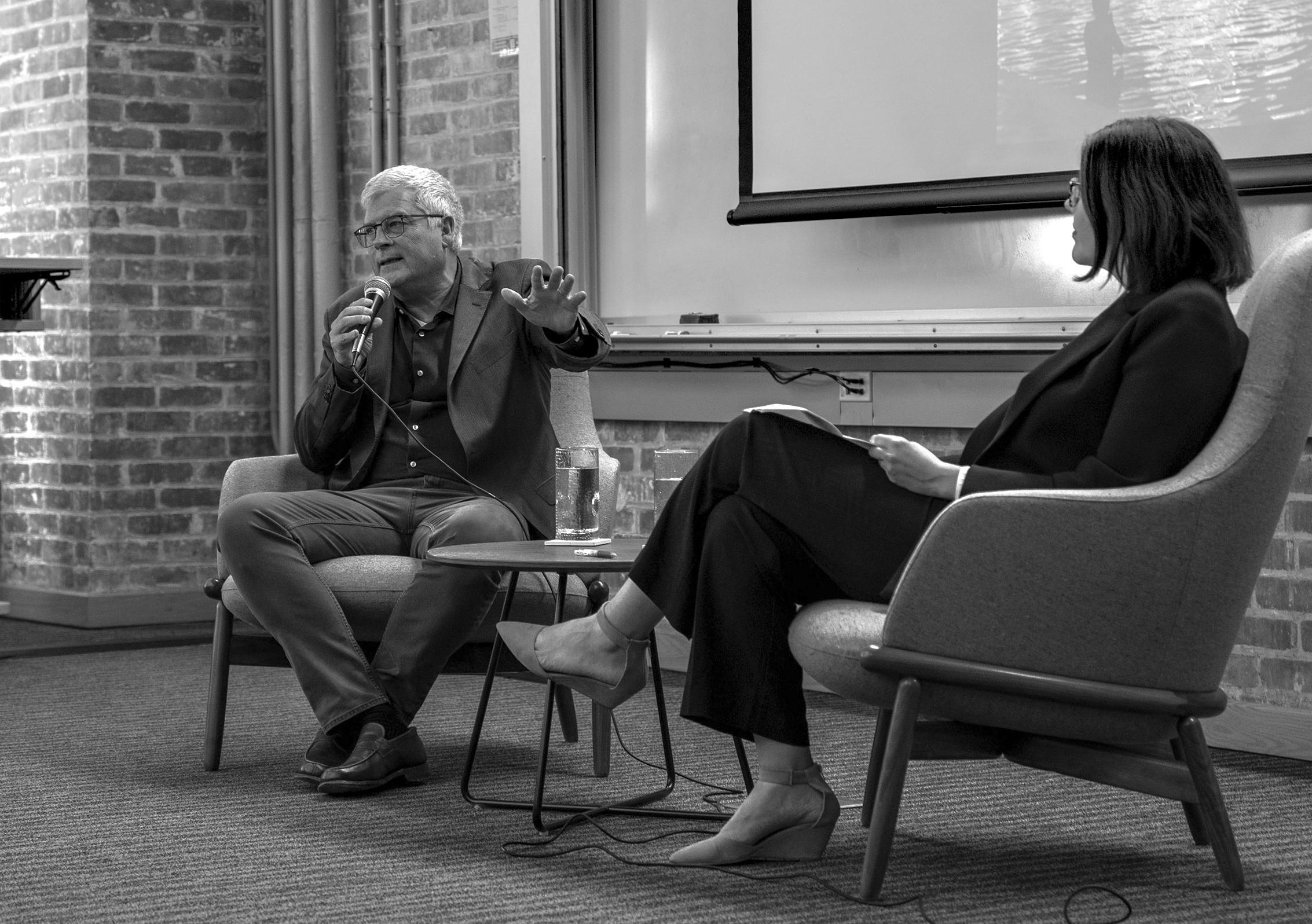
“When coal starts going down, the Indian railway is still going to have a challenge because its single largest and most profitable freight class is coal,” Spindle said. “It’s now going to have to restructure its budget, but that can be tricky because all of these profits from coal go to financing subsidized tickets for regular Indians so they can ride the train for virtually free. The economy functions on that — they all need those tickets. You also can’t easily lay off people.”
Spindle said developing countries face unique challenges in adopting clean energy. “I think that’s the dilemma that most of the developing world is really in,” Spindle said. “How do you make an energy transition that requires quite a lot of resources up front, even though the payoff comes later? At the same time, the longer that gets delayed, the harder it is to get those funds and make those investments, (and) the more you’re exposed to the effects of climate change.”
Spindle described the ways uneven adoption of clean energy technologies has reshaped national economies, particularly in places where it is difficult for utilities to adapt quickly. He said Pakistan has seen a
large amount of solar panels imported into the country.
“You basically got anybody who can afford solar panels buying solar panels, sticking them everywhere they can stick them — on their roofs, on their balconies, on their front lawn,” Spindle said. “And then basically no longer using any energy from the grid, which has left the country’s utility — which was not in great shape in the first place — in just a horrible state. And one of the problems it’s causing is that the poorest of the poor who can’t afford solar panels in the front yard or on the roof are facing higher electrical bills.”
Spindle said clean energy solutions are still in the early stages of development, despite rapid progress.
“I’d say one of the biggest revelations I’ve had is that really things that we think of as somewhat mature clean energy technologies — solar panels, wind, certainly batteries — they’re doing really well,” Spindle said. “But when you start to talk to the people in these industries, you realize that there’s so much more that’s going to happen in just the technological breakthroughs in solar, for example.”
In an interview with The Michigan Daily, Rackham
student Stephanie Smith, an event attendee, said she learned the U.S. is falling behind in sustainable development.
“I think my biggest takeaway was just that the United States is continuing to fall behind globally, especially in terms of electric vehicles, but generally in our sustainable energy transition,” Smith said. “Even developing countries around the world are going to push ahead with implementing these technologies, but they won’t be from companies that come from in the United States. It’s interesting to hear perspectives that confirm that from someone who’s been a correspondent outside of the U.S.”
Following Spindle’s talk, the William Davidson Institute hosted a happy hour allowing students, researchers and alumni to further connect over energy and climate reporting. Caitlin Jacobs, LSA sustainability program manager, told The Daily she was excited to see how U-M alumni have applied themselves across the world.
“I work in LSA, Bill is an LSA alumni, and so that was one reason I was really interested to be here,” Jacobs said. “It’s just always exciting for me to see where students with different backgrounds can wind up.”
CLAUDIA MINETTI Daily Staff Reporter
Painting the Diag in hues of green and blue, 46 environmental sustainability and climate justice organizations came together for the University of Michigan’s 30th annual Earthfest, welcoming more than 200 students, faculty and locals. Earthfest promotes different environmental sustainability projects across the University and Ann Arbor, featuring opportunities for students to become involved in sustainability, climate change mitigation and environmental justice. The event, organized by the Office of Campus Sustainability, School for Environment and Sustainability, Student Life Sustainability and Graham Sustainability Institute, was held during the University’s inaugural Climate Week 2025. The initiative aims to promote decarbonization and environmental and climate justice to facilitate collaboration across different campus groups.
Organizations at the event included Clean Up Campus, the Erb Institute and the Student Sustainability Coalition, in addition to local community organizations like the Leslie Science and Nature Center,
Huron River Watershed Council and the Washtenaw County Resiliency Office. Interactive opportunities were also featured, including samples of cherry tomatoes, button making and snake petting.
Maaike Wielenga, marketing and outreach coordinator for the Huron River Watershed Council, told The Michigan Daily in an interview Earthfest is a great way for individuals to learn about and connect with different environmental initiatives.
“It’s really cool to see all the different types of people coming around, and even if you’re not into water quality, now you know a little bit about the Grand River, or maybe you’re super into water quality and want to intern for us over the summer, and made that first connection,” Wielenga said.
“I think it’s a really great way just to network with people and see all the different organizations out here doing great work.”
LSA sophomore Penelope Walke attended last year’s Earthfest. Returning to this year’s Earthfest as the chair of TREES, Walke said individuals should not feel intimidated to engage in environmental sustainability in an interview with The Daily.
“I think there are a lot of perceptions out there that you have to be a certain type of
person to really be involved in sustainability aspects,” Walke said. “It’s important to advertise that anyone can get involved in sustainability. It’s not intimidating. It’s more of just making daily changes in your life, and they can be small, they can be big, but anything really makes a difference.”
In an interview with The Daily, LSA sustainability coordinator Jenna Steele said that LSA Sustainability focuses on increasing awareness and improving sustainability across campus.
“Being in a facilities unit within a college, a lot of what we’re doing is driven by student activism, what students want to see, what students want the buildings to look like (and) what classes they’d like to see,” Steele said.
On Oct. 1, the LSA Building unveiled a new art installation: a monarch butterfly roost created from recycled materials.
At Earthfest, attende es could add to the roost by painting or coloring in a drawing of a monarch butterfly.
Steele said the art installation aims to inform students about the importance of the monarch butterfly to Michigan and open broader conversations about humanity’s impact on the climate.
Stanford Lipsey Student Publications Building 420 Maynard St. Ann Arbor, MI 48109-1327 734-418-4115 www.michigandaily.com
ZHANE YAMIN and MARY COREY Co-Editors in Chief eic@michigandaily.com
ELLA THOMPSON Business Manager business@michigandaily.com
NEWS TIPS tipline@michigandaily.com
LETTERS TO THE EDITOR tothedaily@michigandaily.com
EDITORIAL PAGE opinion@michigandaily.com
PHOTOGRAPHY SECTION photo@michigandaily.com NEWSROOM news@michigandaily.com CORRECTIONS corrections@michigandaily.com
ARTS SECTION arts@michigandaily.com
SPORTS SECTION sports@michigandaily.com
ADVERTISING wmg-contact@umich.edu
’95 Managing Editor cledezma@umich.edu
FIONA LACROIX Digital
“(Monarch butterflies are) really important here because they are that generation that make it back down to Mexico,” Steele said. “So (we’re) opening those doors to talk about climate and what Michigan looks like as a climate haven … Opening those bigger conversations of, ‘yes, monarch migration is really cool and it’s really pretty to look at,’ but also the deeper, human issues of climate.”
In an interview with The Daily, LSA sophomore Micah Heerema said Earthfest is a great way to amplify student voices and shows students don’t need to be directly studying the environment to participate in environment sustainability. Heerema also said she appreciated the University’s engagement with and commitment to spreading awareness about climate change through events such as Earthfest and Climate Week.
“I think that the University is a really well-respected and huge institution,” Heerema said. “When really big institutions make moves in sustainability, and then acknowledge things like Climate Week and facilitating student voices — that’s really cool. Being a part of that is awesome, especially as somebody who’s passionate about the environment and sustainability.”
JONATHAN WUCHTER and ZACH EDWARDS Managing Sports Editors sports@michigandaily.com
Senior Sports Editors: Annabelle Ye, Alina Levine, Niyatee Jain, Jordan Klein, Graham Barker, Sam Gibson
CAMILLE NAGY and OLIVIA TARLING Managing Arts Editors arts@michigandaily.com
Senior Arts Editors: Nickolas Holcomb, Ben Luu, Sarah Patterson, Campbell Johns, Cora Rolfes, Morgan Sieradski
GEORGIA MCKAY and HOLLY BURKHART Managing Photo Editors photo@michigandaily.com
Senior Photo Editors: Emily Alberts, Alyssa Mulligan, Grace Lahti, Josh Sinha, Meleck Eldahshoury
Editors: Graciela Batlle Cestero, Irena Tutunari, Aya Fayad
ALENA MIKLOSOVIC and BRENDAN DOWNEY Managing Copy Editors copydesk@michigandaily.com
Senior Copy Editors: Josue Mata, Tomilade Akinyelu, Tim Kulawiak, Jane Kim, Ellie Crespo, Lily Cutler, Cristina Frangulian, Elizabeth Harrington
AHTZIRI PASILLAS-RIQUELME and MAXIMILIAN THOMPSON Managing Video Editors video@michigandaily.com
Senior Video Editors: Kimberly Dennis, Andrew Herman, Michael Park
AVA CHATLOSH and MEGAN GYDESEN Managing Podcast Editors podeditors@michigandaily.com
Senior Podcast Editor: Quinn Murphy, Matt Popp, Sasha Kalvert
MILES ANDERSON and DANIEL BERNSTEIN Managing Audience Engagement Editors socialmedia@michigandaily.com
Senior Audience Engagement Editors: Dayoung Kim, Lauren Kupelian, Kaelyn Sourya, Daniel Lee, Quinn Murphy, Madison Hammond, Sophia Barczak, Lucy Miller, Isbely Par SARA WONG and AYA SHARABI Michigan in Color Managing Editors michiganincolor@michigandaily.com
ANNA MCLEAN and DANIEL JOHNSON Managing Focal
OLIVIA VALERY Marketing Manager
Combining a children’s play area and a cafe, this new business offers coffee, wine and child care
KAYLA LUGO Daily Staff Reporter
Recess Work & Play Cafe opened on South Ashley Street this September, combining a children’s play area with a menu of assorted pastries, breads and spreads, coffee, beers and wine. Recess Cafe aims to create a third place for Ann Arbor parents to get a drink with friends or do work while employees watch their children in the play area.
Recess Cafe charges $10/hour for child care services Wednesday through Sunday, 9 a.m. to 7 p.m. and until 8 p.m. on Friday and Saturday. Children aged zero to one can attend for free. Bookings for a ‘playpass’ can be made on the website for one and two-hour time blocks, and party reservations are also available by request.
Recess Cafe owner Thressa Nichols told The Michigan Daily in an interview that young families play an important role in building strong communities.
In an interview with The Daily, Ann Arbor resident Shamus Craft said the cafe’s location makes it a convenient stop for locals.
“I think this is a great location,” Craft said. “I can’t speak for other folks, but there seems to be a lot of foot traffic down here. I myself come down (to) this area a lot just to walk around and see what storefronts are out, see what’s new.”
In an email to The Daily, Operations Manager Amelia Pointer wrote in addition to families, students have also quickly become the core of the cafe’s customer base.
“We’ve also been seeing regulars already, which is amazing — it’s been so much fun getting to know the families in the area,” Pointer wrote. “But we have found that there are students that come to study; we tend to be less busy than
“People put down roots, they get invested in the schools, they go out to eat,” Nichols said. “They stimulate the economy in a lot of ways. And so I just felt like we needed more places to help families know that they could do that here.”
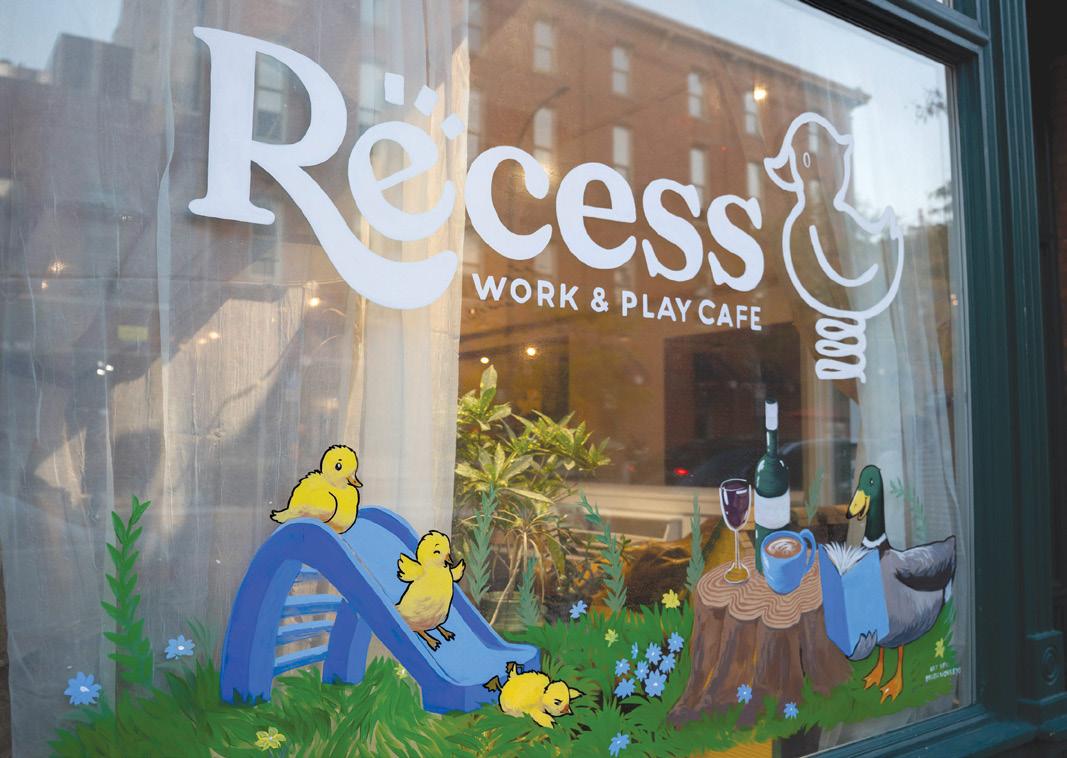
some other cafes, especially around nap time, so we’re a reliable space for some good coffee and snacks while working on homework or studying.”
In an email to The Daily, Rackham student Himani Jasewicz, who visited the cafe with her husband and children, said the space provided a rare balance between parenting and productivity.
“My husband and I were able to chat, and I was able to get some schoolwork done while the kids independently played,” Jasewicz wrote.
Pointer also explained the extensive staff training that went into preparing for the opening, from coffee and wine education to child care experience.
“Before we opened, we had our entire staff do trainings with both Hyperion (our espresso supplier) and Spencer (who helped us determine our wine selection),” Pointer wrote. “We also did several training sessions leading up to open running through logistics; how to balance between being behind the counter and in the space, how to read the space and gauge customer needs based on what they see. Most of our employees come from child care backgrounds as well, and everyone enjoys working with children, so that was incredibly helpful as well.”
In addition to the cafe’s partnerships with local businesses for their wine and coffee, Recess Cafe offers baked goods from CRUST. Nichols said she wanted to prioritize higher quality rather than prepackaged items on the food menu and ensuring environmental sustainability.
CONTINUED AT MICHIGANDAILY.COM

Shows falling reports of depression, anxiety among college students for the third year in a row.
KAELYN SOURYA Daily Staff Reporter
Content warning: This article contains mentions of suicide.
The latest findings from the University of Michigan’s annual Healthy Minds Study conducted by the Healthy Minds Network, a national research organization dedicated to the mental health of adolescents, showed falling reports of depression, anxiety and suicidal ideation among college students for the third year in a row.
The Healthy Minds Network conducts the online survey annually, surveying students from across U.S. higher education institutions. The most recent study from 20242025 surveyed more than 84,000 students across 135 colleges and universities. According to the survey, the
rates of reported depression symptoms decreased from 23% in 2022 to 18% in 2025. Rates of anxiety and suicidal thoughts showed similar declines with moderate-to-severe anxiety symptoms dropping from 37% in 2022 to 32% in 2025, while suicidal ideation rates fell from 15% in 2022 to 11% in 2025.
In an interview with The Michigan Daily, Healthy Minds Network statistician Eric Voishoski said the results suggest a consistent downward trend, rather than a temporary fluctuation.
“This is the third year in a row that we’ve seen college students reporting lower rates of negative mental health systems,” Voichoski said.
“For the first couple of years when we saw these symptoms decreasing, we were hopeful and optimistic but we weren’t sure whether it was just a blip
on the radar, and now we’re feeling pretty confident that we can call it a trend and we’re just hoping that it continues in this direction in the years to come.”
In an interview with The Daily, Michelle Kees, clinical associate professor at Michigan Medicine’s Department of Child and Adolescent Psychiatry, said the improving mental health of college students is promising when compared to lower rates in the past.
“It has been so enlightening for me to see this generation, and there is absolutely a greater openness and awareness to recognizing things like anxiety,” Kees said. “For so long, it’s only been about increases, so these results provide a helpful counter narrative and show that change is possible.”
CONTINUED AT MICHIGANDAILY.COM
ALYSSA TISCH Daily Staff Reporter
Each month, The Michigan Daily publishes a compilation of bills in the Michigan legislature for students at the University of Michigan to know about.
The following article explains five bills that have been introduced, passed or signed into law by the Michigan legislature or Gov. Gretchen Whitmer throughout the month of September.
1. State budget
Status: Passed by the House and Senate
House Bill 4706, introduced by Rep. Ann Bollin, R-Brighton Township, was passed Friday, creating a nearly $81 billion spending plan. The spending plan includes $2 billion for roads, a reduction of nearly 2,000 government “ghost jobs,” tax breaks for senior citizens, continued offerings of free student meals and more. The bill was passed two days after the Michigan Legislature failed to pass a budget by Oct. 1, as required by Michigan’s constitution. The Legislature avoided a government shutdown in those two days by passing a continuation budget, allowing the government to stay funded for an additional week. In a press release, Whitmer wrote the passage of the bill will help state residents.
“Today’s balanced, bipartisan budget is a big win for Michiganders,” Whitmer wrote. “We brought members on both sides of the aisle together to provide tax breaks to seniors and working families, protect access to affordable health care, feed every child
free meals at school, help our students succeed academically and ensure Michiganders are safe in their communities.”
In a separate press release, Jon Bumstead, R-Norton Shores, wrote that the bill — which allocates less money than last year — is a victory in reducing wasteful spending.
“It may have taken extra time to get it here, but we have passed a responsible budget that puts Michiganders first by working to reduce wasteful spending and focusing on our shared priorities, such as fixing the roads, investing in our schools and public safety and providing meaningful tax relief,” Bumstead said.
The bill was sent to Whitmer Friday morning for her signature.
2. Tax on marijuana towards fixing potholes
Status: Passed by House and Senate
House Bill 4951, introduced by Rep. Samantha Steckloff, D-Farmington Hills, was passed by the House Sept. 25 and the Senate Friday. If signed into law, the bill would create a 24% excise tax on the wholesale price of marijuana, with the revenue collected from the tax to be spent on repairing local roads. The idea, a key component of passing the balanced budget, is known as “pot for pot,” or “pot for potholes.” The House Fiscal Agency Governing Committee estimates that $420 million would be collected annually through the tax.
The 24% wholesale tax is lower than Whitmer’s initial 32% proposal. The proposal was a part of Whitmer’s “Mi Road Ahead” plan announced in February. In the initial press release, Whitmer wrote she has
engaged in long and continued efforts to improve Michigan roads.
“Since day one, I’ve been focused on fixing the damn roads, and while I’m proud of the progress we’ve made, there’s still a lot more to do,” Whitmer wrote. “Today, I’m excited to introduce my brandnew plan that provides a longterm, sustainable solution to fix our roads so we can help more Michiganders stay safe on the road, save money, and get where they’re going faster.”
Some Michigan cannabis advocates claim the tax is far too high. Industry advocates and workers held a rally on the capital steps Tuesday to protest the tax.
The bill was sent to Whitmer for her signature Friday morning.
3. Alert for missing senior citizens
Status: Passed by the House
House Bill 4362, introduced by Rep. Gina Johnsen, R-Portland, was passed by the House Sept. 3. The bill’s goal is to create a medical alert system plan for missing senior citizens or vulnerable adults. The system, using existing federal technology, would allow first responders to send alerts to the mobile phones of people across the state.
In a press release, Rep. Kathy Schmaltz, R-Jackson, who voted for the bill, wrote she believes this emergency system could save lives.
“Putting a Silver Alert system in place will give families hope in their most desperate moments,” Schmaltz wrote. “It will make sure vital information reaches our communities quickly, where it can save lives and reunite families.”
The bill was referred to the Senate Committee on Civil Rights, Judiciary, and Public Safety Sept. 9.
4. Ban of explicit material and material depicting transgender individuals
Status: Introduced to the House
House Bill 4938, or the “Anticorruption of Public Morals Act,” was introduced to the House by Rep. Josh Schriver, R-Oxford, and five co-sponsors Sept. 11. The bill would ban all pornography online, with exceptions for academic work, and would also ban the depiction, description or simulation of transgender people. The bill’s language — which prohibits material featuring a person presenting themselves as their non-biological sex — could also potentially apply to drag queens.
In a social media post following the introduction of the bill, Schriver wrote the bill would protect families.
“Don’t make it, don’t share it, don’t view it,” Schriver wrote. “These measures defend children, safeguard our communities, and put families first.”
If passed, Michigan would be the first state to enact a total pornography ban. The bill states that if a platform, individual or other entity allows this material to be online or accessible, they would receive a felony with a potential prison sentence of up to 20 years and/or a fine of up to $100,000.
The bill was referred to the House Judiciary Committee.
5. Safeguarding homeowner property rights
Status: Signed into law
House Bill 4524, introduced
by state Rep. Douglas Wozniak, R-Shelby Township, was signed into law Tuesday. The bipartisan act gives homeowners more time to protect their property rights by extending the deadline for claiming a property interest, or direct ownership of a property, including driveways and walking paths, by two years. It also clarifies rules regarding land and home ownership.
In a press release, Wozniak wrote this bill will make homeownership easier.
“This legislation ensures Michigan’s land records are accurate, reliable and easier to navigate,” Wozniak wrote.
In a separate press release, Whitmer wrote that this bill and its clarifications will safeguard homeowners from any lastminute issues.
“I’m proud to sign this commonsense, bipartisan bill that will protect Michigan homeowners,” Whitmer wrote.
“This bill will clarify the rules for property transfers, so when you go to sell your house or land, there are no surprises that can get in the way. It will lower costs, help keep property records up to date, and make government more efficient. Let’s keep making sure our government works for Michiganders throughout the state.”
“Homeownership is one of the most important investments a family can make, and our laws should give people confidence in their property rights.”




IAN GALLMORE Daily Arts Writer
I want you to paint me a picture. Not metaphorically, but literally — oil paint and all (okay, maybe watercolor if you’re feeling it). I don’t want a vista or a bowl of fruit. I want something more personal. More intimate. I want you to paint a picture of your bedroom.
What will I see? A neatly tucked in bed, curtains that match the bedspread and a photo wall? A flurry of movie posters and albums decorating the space? A mix of clothes strewn about, blending in with sheets hanging off the bed? If I’m being honest, as much as my parents would love to see a freshly-made bed and tidy desk (they drilled the “Make Your Bed” by Admiral William H. McRaven speech into me), you’re much more likely to stumble upon the reality of a life spent with sparse moments to think about seemingly irrelevant chores. Though I’m not the first to share this sentiment, I believe my bedroom serves as a physical representation of my headspace. Unfortunately, these days, that means a mess of books for class, calendar invites, clothes from the past three days and a more-thanhealthy dose of stress, all tinted with the existential dread of graduation. If I knew how to paint, it would certainly be one hell of a surrealist piece.
Naturally, you and I are not the only ones who’ve attempted the task (that is, if you indulged my request). The most famous of bedroom paintings, the one that you’ve probably been patiently waiting for me to mention, is “The Bedroom” by Vincent van Gogh, also often referred to as “Bedroom at Arles.” It’s one of those paintings that you see and think, “Oh, interesting” and vaguely know as important in some way. Not quite Mona Lisa famous, but could safely be on a tote bag or T-shirt —
performative males, you should be well aware of this.
For some reason I can’t quite put a finger on, the painting has stuck with me ever since I first saw it.
A simple depiction of a bedroom: two chairs, a table. Simple enough to make me want me want more — to know its story. Modern biographies of Van Gogh rely on his letters, mostly written to his brother, Theo, and a close friend, Paul Gauguin. Beyond a beautiful fraternity — no, not the Greek kind, the brotherly kind — these letters reveal stunning insights into Van Gogh’s personal life, and key details behind his most famous works. In reference to The Bedroom, which Van Gogh described as ‘A no. 30 canvas of my bedroom,’ the letters reveal that he completed it after resting “for two and a half days.”
On the surface, this sounds like a quick cold, the kind you hope won’t set you back a week of homework.
Van Gogh himself blames it on the stressors of moving to Arles and setting up his new home. But looking beyond these words, there becomes another contributing factor: Van Gogh’s struggles with mental illness.
At this time in Van Gogh’s life, his struggles with his mental health are well documented. He envisioned his time in Arles to lead to a burst of creativity, his home becoming a hub for artists.
But his mental illness, a mixture of depression, anxiety and mania, meant that this reality never came to fruition. Months later, Van Gogh would infamously cut off his own ear in the wake of a particularly nasty argument with Gauguin, the first artist who had come to live with him. Van Gogh, aware of his illness, would check himself into a mental hospital afterward, spending a year there. Painting, for Van Gogh, became a way of continuing to move through the world; a type of therapy meant to interpret reality in a more palatable form.
With this context, “The Bedroom” takes on a new meaning. It becomes an escape, a secret paradise that Van Gogh wishes to create for himself: A version of his bedroom, and by extension his mind, that inspires “utter repose.”
A place of healing, a reality filled with comforting furniture and the familiarities of daily life: his coats, a towel, the window to the outside world (notably closed). His version of peace — a clean bedroom, and therefore, a clean mind. And with that, let’s call it a day. A classic example of art as therapy, working through your own emotions on the canvas. Van Gogh goes off to live a happy life, full of joy and whimsy, thanks to the therapy provided by his painting prowess. Except, look at “The Bedroom” again. Does something feel … off? Maybe it’s the clear perspective issues, the room supposedly trapezoidal over rectangular. Or potentially the faded colors, almost too agreeable. To me, it’s the paintings on the right wall. Van Gogh’s wink to himself, mini renditions of his self-portraits. Yet these depictions of self clearly neglect to follow the skewed point perspective of the rest of the painting. They stick out. These depictions of Van Gogh break the ontology of the scene, forcing the bedroom to cave in on itself. An implosion precipitated by the self. Van Gogh did not go on to live happily ever after. After staying in a mental hospital in Saint-Rémy-deProvence for a year, he would leave in May of 1890 for Auvers-sur-Oise. He lived there for two months before taking his own life in July 1890. Throughout his last year and a half, he would create more than 150 paintings, and almost one a day in his final months. Many of these consisted of orchards and natural vistas, scenes meant to inspire peace. But none, in my opinion, are as personal as “The Bedroom.” CONTINUED AT MICHIGANDAILY.COM
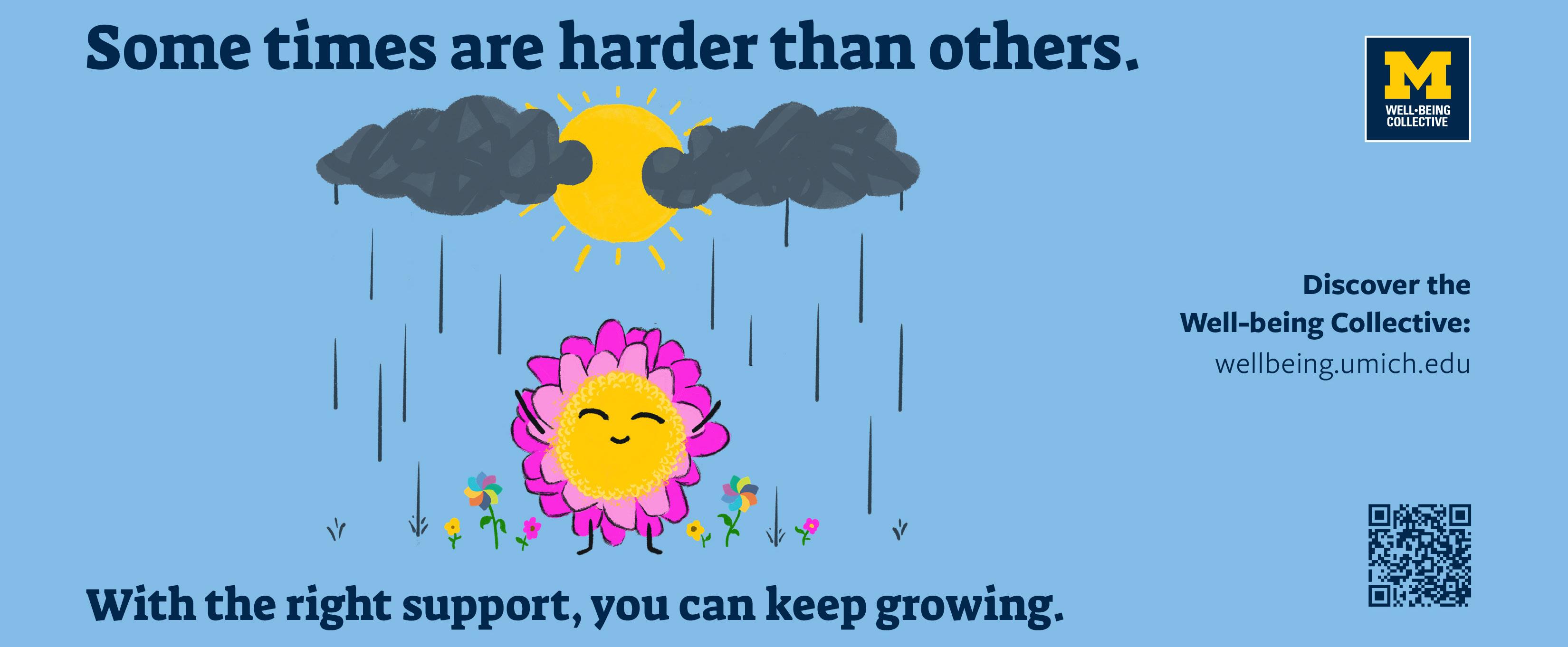




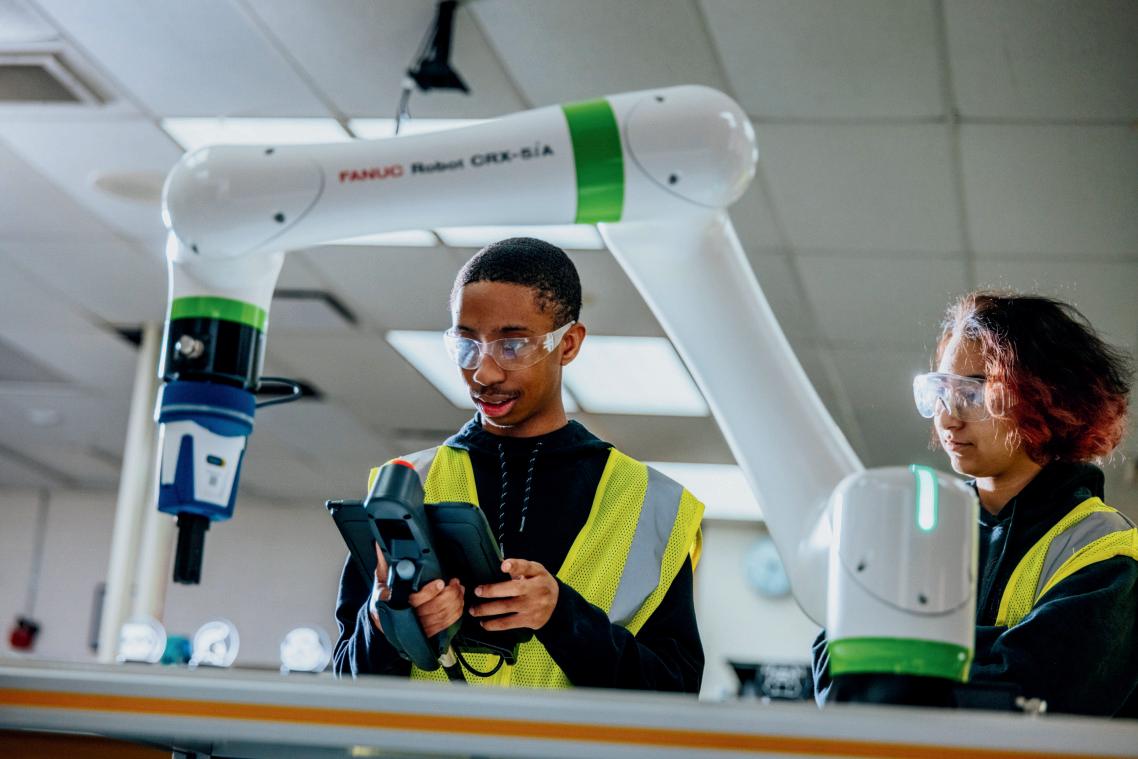

ode to myself — all that I was and all that I am. It cradles me in my most vulnerable moments: sex, sleep and sorrow. It holds life within its four paper-thin walls. It welcomes me home every night like a close friend. But like in any friendship, there are moments of strife. Its welcome feels warm until I’m tired of myself and, just for once, want to exist without its
wandering eyes — without all my past selves staring back at me with longing eyes through the posters on my wall and stuffed animals atop my bed. Still, most of the time, I find its volatile nature endearing. For now, though, I’ll keep all that under my pillow. Join Arts writers for an assortment of bedtime stories: the frustrating, the fascinating and the forgiving.
My love-hate relationship with bed rotting: The nearly good, the mostly ugly
It can be nice, sometimes. Lying on the top of your bed, your feet tucked into the covers as your eyes glaze over and your thumb scrolls through an endless abyss of meaningless content. It’s nice that it’s meaningless — your brain finally gets to be turned off after hours of overwork and overstress.
It’s a simple, almost artful method of instant gratification.
These are the good days of bed rotting. It’s what keeps you from throwing your phone into the ocean because you know you’re horribly addicted. The calm, lulling feeling of surrendering your attention for a couple of hours before bed is too good to give up. You need the “me time.” This is self-care. You occasionally toy around with the idea of buying a flip phone, but always decide you need your iPhone for moments of sweet relief like this.
But when it’s bad, it’s bad. You get back to your room after a tough day and you think about all the things you can do to unwind, but you pull out your phone in the meantime. You know you could draw, or call your friends, or pick up the guitar that’s gathering dust in the corner — but before you realize, you’ve already started the Doom Scroll. Your thumb has already gained momentum, and without even noticing, you’ve already gotten horizontal, lying on your bed with your feet tucked in. There’s no escaping now. While you lie there, paralyzed, you think about all the things you could be doing instead of wasting your time. Yet you continue to scroll for hours. And hours.
The worst of the worst is when you can’t put it down for anything.
Not when it hits midnight, or 1:00 a.m. When you know you want to stop, but for some reason, it feels as though your body has caged your brain. Your eyes hurt even as you feel the regret setting in: It’s 2:30 a.m. and you have a class in the morning. You want to put the phone down, but it won’t move out of your hands. You feel like garbage. You’re not just wasting time anymore. You’re wasting your life.
While you mindlessly consume the content farming slop or whatever internet rabbit hole you’ve fallen into for the night, your brain continues to pulse: What is wrong with you?
The tightrope between momentary release and selfdestruction is nearly hair-thin.
There is no balancing act — you’re destined to fall. The truth is — and you already know this — that your phone wants you to wither away under the blue light of its screen. You know that every app is designed to steal your attention and keep it as long as possible, and you know the algorithm isn’t just tailored content meant to entertain you — it’s also meant to jail you.
You know the odds are against you and the game is rigged, but you can’t help but keep playing. You know all of this and, somehow, you’re back in bed with nothing but the harsh artificial light illuminating your face.
No amount of deleted social media or screentimes and downtimes or productivity apps is going to change the fact that you keep reaching for your phone the moment you feel the slightest modicum of boredom. You feel fidgety during class and keep your phone next to your notebook, turning it over every other minute to see your notifications. You
walk to class with headphones on and skip through songs before they’re over. You can’t fall asleep without a YouTube video on in the background.
When does bed rotting just become rotting?
I’ve been dealing with this question for a while. I’ve tried every trick in the book. I’ve deleted Instagram, Snapchat, Twitter, TikTok and YouTube. I have screentime set up with a parent lock, and I have a widget on my home screen that tells me exactly how much time I’ve spent online that day. But no matter what I do, I keep seeing the number rise.
Maybe I’m in the minority, and everyone else has their shit together. I’ve met people who can scroll on Instagram for 10 minutes and calmly put their phones down and get back to work. I know people who use TikTok to unwind before bed and fall asleep by 10 p.m.
But I also know people who can’t stand the sound of silence without the interruption of a video.
I think phones have outlived their usefulness — their practicality has morphed into a parasitic leech, obscuring the little moments in life we’ve forgotten about. There’s something so alluring about picking up your phone the second you feel bored or anxious or (God forbid) human. I miss boredom. I miss ennui and awkward silences among strangers and sitting with your own thoughts, however difficult that may be. I miss having to participate in my own life in spite of its unpleasantries.
I don’t want to rot in bed anymore. I want to play my guitar again and draw when I’m bored and, honestly, touch grass. I want to be me again. I think bed rotting is slowly killing me, and maybe you, too.

MINA TOBYA Daily Arts Writer
Writers are sad children — at least that’s the conclusion my writer friends and I have come to. We all started out as lonely kids clutching a pen in our bedrooms at night. In our sanctuaries, decorated to look like the inside of our minds, we bore our despondent souls to the only thing we were brave enough to. In our heads, no one starts writing because they’re happy.
Joy is something people can share freely. It’s easy to talk about. The other side of the coin falls under an implied code of silence. No one would want to hear it, you think, and even if they did, what would that change?
Whether sadness arrives at your door too young as a result of your environment or of the wheels in your mind turning the wrong way, it becomes your burden to bear alone. Maintaining this silent oath to ourselves turns the common bedroom into a sacred hermitage.
Better to sit under the covers at night and drive yourself in circles thinking about the grandness of your own emotional heaviness than to go outside and try to quell it. Some
of us might’ve scrolled through dark corners of the internet for hours or stared at the wall, watched movies or shows to make ourselves feel less alone — any number of rituals to get out of our own heads. Writers quickly find that a book is the best way to escape. It’s enough to keep us going, imagining a world beyond ourselves.
But at a certain age we begin to find our lives reflected back at us in this art. By the time we hit our preteens, sadness and angst are expected of our age. We used to carry these emotions while holding onto the notion that they couldn’t be talked about. Despair becomes less taboo in the stories we’re now old enough to consume, however, and we don’t feel so out of place anymore. These miseries were a secret we’d kept so long it would be sacrilege to reveal them, even under the sneaking suspicion they lurked within us all. The shame convinces us that this is an isolated phenomenon, until we come across others — authors of books who bore sorrowful souls. All the understanding we needed was the confessions of tortured writers that came before. Sylvia Plath and Edgar Allan Poe, Franz Kafka and J.D. Salinger — all people
who put their pain to the page and, in so doing, cemented its heaviness there, taking its weight off their shoulders. So, we pick up a pen. It’s a sort of divine confession. With every ill-chosen word and wrongly structured sentence, the circles running in our heads turn into smooth lines staring back at us from the page. The heaviness doesn’t disappear, but there’s somewhere for it to go. The years go on and we read more of these tormented writers’ pain and come to think of it as a rite of passage. It isn’t wasted, this sadness — it’s a twisted initiation into the cult of writing.
The trouble comes when young writers start to believe the only initiation into a cult of great art is great pain. To a kid whose world begins and ends within the four walls of their bedroom, whose bookshelf is full of people who emphasize their pain, the association between art and sadness makes sense. But to make great art, the kid needs to grow up and expand their world. It takes a long time to figure out that the writers they look up to are more than their sadness — and that they themselves are, too.
CONTINUED AT MICHIGANDAILY.COM





Despite Michigan football’s bye week, The Big House succeeded in selling out the entire stadium.
Multi-platinum Grammy-winning artist Zach Bryan’s highly anticipated concert attracted a
record number of fans, with an estimated 112,408 attendees. Fans flocked to Michigan Stadium to see what was to become the largest ticketed show in United States history.
As the gates opened at 4:00 p.m. visitors from Michigan and beyond filled the Big House, donning
cowboy hats and boots, to see the first openers: Keenan O’Meara, Joshua Slone, and Ryan Bingham and The Texas Gentlemen.
As fog wafted through Bryan’s entrance to the field,
the University of Michigan’s self-proclaimed anthem, “Mr. Brightside” by The Killers, triggered a booming singalong from the audience. Merging with Bryan’s “Overtime,” the longawaited artist entered the field and joined the rest of his band onstage.





Near the midpoint of the show, Bryan brought out his special guest band, The War and Treaty, to sing “Hey Driver.” Bryan’s good friends and Michigan-natives, Michael Trotter Jr. and Tanya Trotter, added their powerful voices and Michael’s piano skills to the song, forging a memorable medley.
As Bryan performed “Quittin’ Time,” an introduction scene of “The Godfather” played on all six big screens. Audience members screamed the lyrics as Bryan sang with increasing fervor. To close the record-breaking performance, Bryan strutted off stage, saying goodbye to the crowd and thanking all of the attendees. Pretending the show was over, Bryan teased the crowd with the idea of a finished set. Fans waited for more than 15 minutes as Bryan’s potential encore approached. Then, bright yellow lights flashed on and then dimmed in the stadium. Students and riled fans boomed, stomping their boots on the bleachers.
Bryan returned to a stage set with 16 instruments to perform “Revival.” In a 15-minute-long rendition of the song, Bryan introduced each instrumentalist by their name, height and hometown before giving them time to showcase their unique talents with a solo. During the very last chorus of the show, fireworks exploded over the stadium, illuminating the night sky with shades of red and gold. Coordinated and planned by AEG Presents and the Michigan Athletics team, the show brought in a whopping $5 million in merchandise sales alone. The concert will be remembered for years to come not only as the first time Michigan Stadium hosted a musical performance, but as a record-holding, colossal musical performance.

ZHANE
Co-Editors
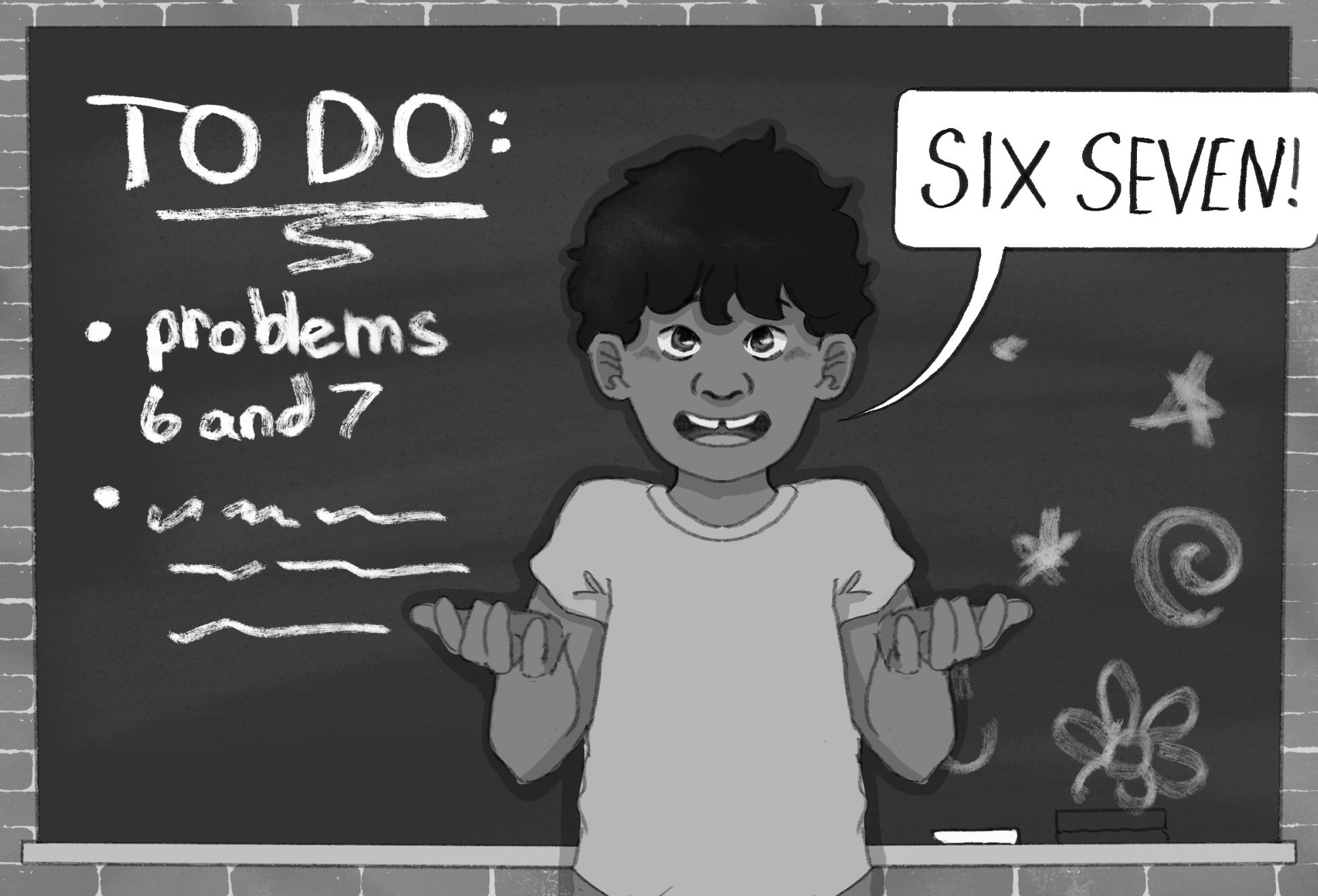
Skibidi toilet. Six seven.
Tralalero tralala. Unc. Chopped. Aura. Sigma. Gyatt. Rizz. These slang words echo in the brains of educators, parents and older siblings. Middle schoolers today constantly spew unfamiliar terminology, referred to as brain rot, and spend significant portions of their time looking at trivial online content. I’ll admit — during student teaching, I almost fell victim to a middle school boy’s deez nuts joke setup. Yet in all of my experiences with education and student dialogue, the same mantra remains true: the kids are okay.
The new era of brain rot is not cause for adult concern. Language is always evolving, and tweens curating a secret code that irks older generations is a rite of passage that is not new to Generation Alpha. New language trends that emerge as teens engage on social media do not signal declining language skills in adolescents, but teachers and parents do have an obligation to educate young students on how to be safe and literate digital citizens when navigating mature content and dangers of the online world.
Every generation creates their own annoying teeny-bopper slang or fads, as waves of popular slang are rooted in inventing a secret language to share an identity with peers. In the ’60s, it was all groovy, and in the 90s it was all phat. For older Gen Z kids, Vine references like “21,” “on fleek” and “what are those?” infiltrated our middle school years. Cycles of youth-based language are culture-specific, and reflect the environments that teens grow up in, so it is inevitable that each generation has weird slang.
Along with each shift in language, concerns from adults and educators about adolescent development rise. Older demographics fail to
understand or relate to the shifts, despite once participating in them themselves, and respond by restricting the usage of slang by banning it or avoiding it altogether. New technologies and cultural shifts separate generations, so even though adults know they were once in their children’s shoes, they fear change because they can’t identify with the shared experience of social media-influenced childhoods.
Though older generations condemn brain rot as the end of formal language, trends in language among teens have little effect on the trajectory of language as a whole. Linguists at Kansas State found that teen slang usually drops away as students develop a stronger self-image and prepare for life outside of school. Unless employers and college professors begin expecting students to speak exclusively in slang in formal settings, this “new wave” of adolescent slang is fairly similar to the countless that have come before. Nonetheless, there is one key difference — the current wave of middle school lingo is mainly spread through social media. Social learning, or individuals learning new behaviors by imitating and observing others, occurs among people who see similar online content. Algorithms on social media track which content keeps your attention, which content you like, share or comment on, then sporadically reinforce your preferences. A 2023 study from the U.S. Surgeon General found that up to 95% of kids 13-17 report using social media. This widespread access to technology means that most slang input or feedback happens online, so spending time online is necessary to understanding it. Age demographics influence social media usage, so if parents only have social media literacy for Facebook, they fail to truly understand Instagram reels or TikTok-based language. Additionally, studies of teen social media addiction
raise concerns about its link to a decline in teen mental health. In the rise of brain rot, overconsumption of low-quality endless loops on social media is tied to negative selfconcept and decreased executive functioning skills. The eccentric phrases rooted in brain rot shouldn’t indicate dysfunction in kids; rather, the patterns in poor digital wellness connected to brain rot and lack of education on the matter is a cause for concern. Therefore, adults should think about what teens view on their devices. Some data suggests that social media usage may start to desensitize children to violence or mature content. Parents have taken action against social media corporations for both addictive elements of the platforms as well as a failure of corporations to protect teens from graphic content. Unfiltered, addictive online platforms allow adolescents to spend hours a day watching media that deteriorates their mental health and exposes them to age-inappropriate content.
This is the real risk of social media — not online linguistic trends. The response to unfamiliar slang should be to help students become safe digital citizens rather than banning the language itself. Educators and parents alike must help students navigate a social media-dominated youth. Schools must prioritize teaching digital citizenship to students without being condescending or blaming them for an overuse of technology that is designed to be addictive. The United Nations International Children’s Emergency Fund works through digital citizenship-related programs to help students stay informed of harms like cyberbullying, and how to avoid the negative effects of social media usage. Rather than one-off assemblies, parents and teachers must deliver more direct instruction to students on safely navigating life online before teens gain full access to technology.
Should have just done the assignment
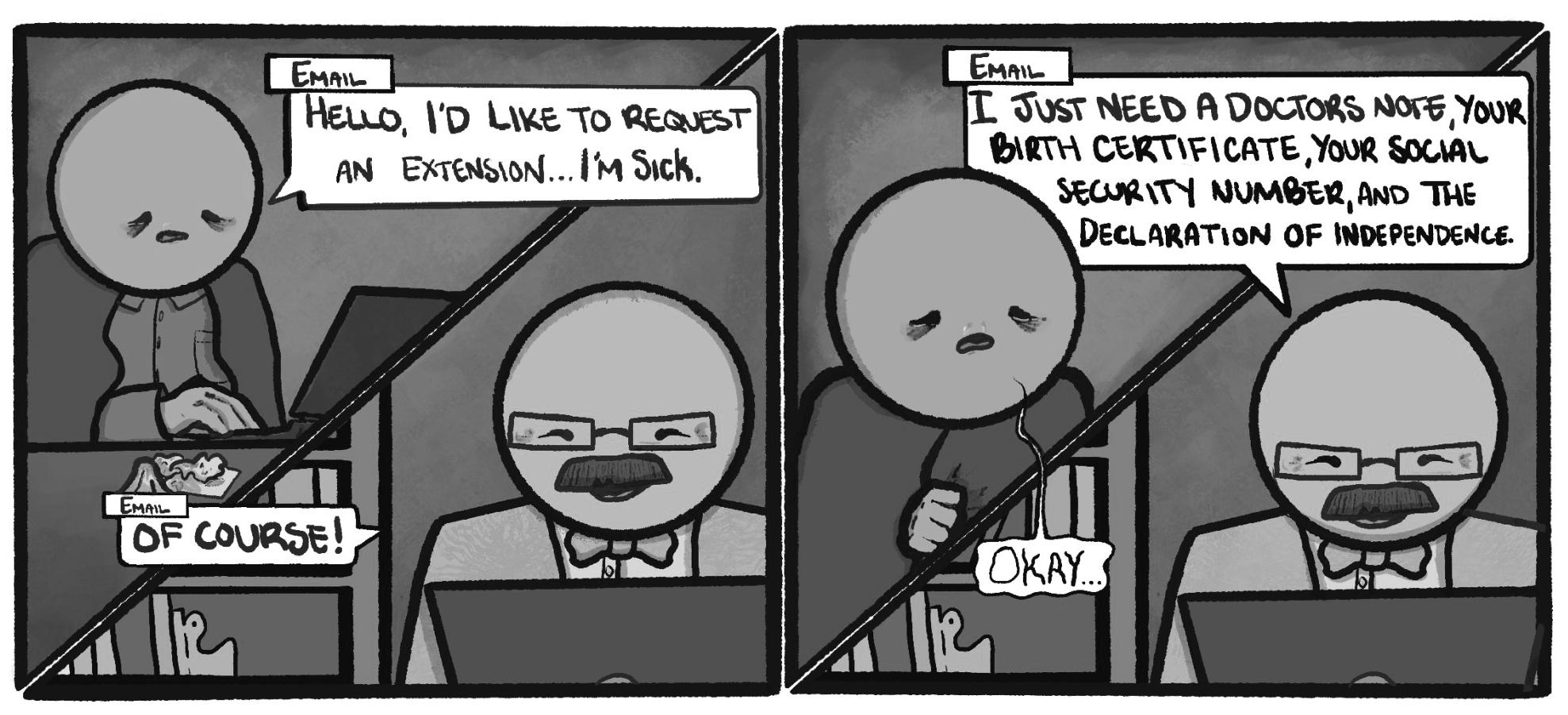
GUNNAR HARTMAN Opinion Analyst
In January 2023, April Valentine went to Centinela Hospital Medical Center in Inglewood, Calif. expecting to give birth to her daughter. After delivering her baby, Valentine complained multiple times about a heavy feeling in her leg. After repeatedly dismissing her complaints, the hospital finally acknowledged her fatal blood clots, but it was too late. Valentine’s death was not the first at Centinela: Officials fined the hospital $75,000 for a previous maternal death earlier that year.
Less than a year later, in October 2023, Sungida Rashid welcomed her newborn daughter at St. Elizabeth’s Medical Center in Boston, Mass. After enduring hours of labor, Rashid’s liver began to bleed. The hospital did not have the proper equipment to save her — they had sold it to cut costs — and after transferring Rashid to another hospital, she too died from hospital negligence.
While these incidents occurred separately, they shared one thing in common: Both women died at for-profit hospitals. The hospital where Rashid died is owned by Steward Health Care, a private equity group that operated more than 30 hospitals across the United States before filing for bankruptcy in May 2024, less than a year after Rashid’s death. As a result, millions of patients languished in deteriorating conditions before eventually losing their health care entirely while Ralph de la Torre, Steward Health Care CEO, reportedly kept his $40 million yacht.
Hospital systems like Steward’s are far from anomalies in America. Private equity’s interest in health care is on the rise and, in the last decade alone, firms have invested more than $1 trillion into the industry. About 36% of hospitals around the country are for-profit, with private equity firms owning about 22%.
For-profit medicine is killing American mothers. The U.S.
healthcare system won’t change overnight, but America must do more to protect its delivery rooms from the inscrutable jaws of the free market.
The core business model of private equity mixes poorly with maternity care. Once private equity purchases a company, it sets about eliminating anything deemed unprofitable.
At the Steward-owned hospital, cost-cutting led to the selling of the embolization coil, a device which could have saved Rashid’s life. Other hospitals across the nation have lost much more. Since 2010, more than 500 hospitals have closed their labor and delivery departments after deeming them unprofitable.
The unprofitability of maternity units stems from many factors, but the most glaring is insurance. For one, obstetric units have some of the highest rates of malpractice lawsuits, which raises the insurance costs hospitals need to pay.
More importantly, Medicaid finances 41% of all births in America. Compared with private insurance, Medicaid reimburses hospitals significantly less. It’s not uncommon for hospitals in areas with high concentrations of Medicaid recipients — both urban and rural — to lose money with each new birth. In the world of profit and competition, this is reason enough to close a delivery unit. Similar profit-maximizing decisions across the country have made it increasingly difficult for expecting mothers to find adequate facilities to deliver their children. Fifty-eight percent of rural hospitals no longer operate delivery units. Thirty-five percent of all counties in the U.S. qualify as maternity care deserts — areas without a single health professional who specializes in maternity care. April Valentine and Rashid were both women of color, and their experiences aren’t coincidental. Minority women suffer disproportionately from maternity care deserts — in 2022, a Black woman was 2.6 times more likely to die from childbirth than her white counterpart.
Still, hospitals that closed
their delivery units argue that the decision prevents them from total closure, avoiding the possibility of more patients losing access to critical care. Under this argument, preserving the existence of private hospitals, even at the expense of their maternity units, is a net positive for society. Inseparable from this claim, however, is the assumption that there are no possible alternatives to the existing private hospital network we have now.
The data may suggest otherwise. One study on health care providers in the United States found that public hospitals delivered more consistent and efficient care than their private counterparts. Another found that while there weren’t noticeable differences in quality of care between public and private hospitals, private hospitals responded much stronger to financial incentives. While some evidence suggests that privately owned fertility clinics operated more efficiently, there is no evidence that this efficiency translates to the delivery room nine months later. Researchers confirmed that the benefits of private hospitals fell mostly on higher income patients, and that hospital privatizations have led to about 920 additional deaths per year, a reminder that privatization is not without human cost. As investment firms continue to buy hospitals and private systems continue to shutter their maternity wards, about 98% of women who choose to give birth at hospitals are at jeopardy if we settle for preserving imperfect and inequitable services instead of seeking reform. Doctors have always lived by the ancient standard to first do no harm — we must hold their employers to the same standard. The continued loss of maternity care poses an urgent threat to American mothers like Valentine and Rashid. State intervention to block maternity ward closures, subsidizing hospitals in low-income areas and promoting the creation of new public hospitals is a start. The invisible hand of the market can do many things — it can’t deliver babies.
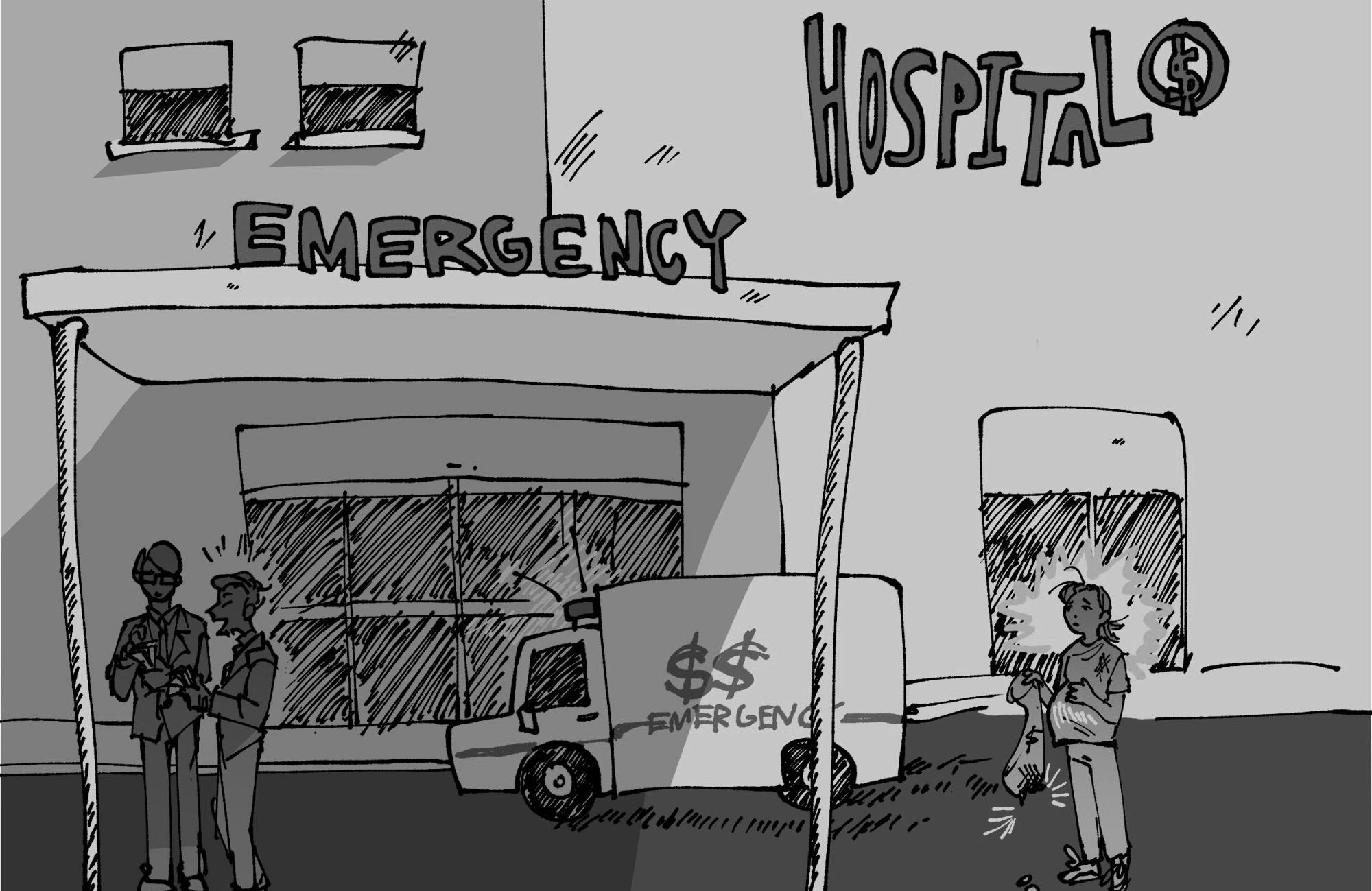

During elementary school, most of us played telephone, a game often used to demonstrate how messages change as they travel from person to person. In a third-grade “girl empowerment program” I participated in, we played it as a metaphor to show what gossip does. But they stressed that gossip doesn’t just produce funny phrases, rather, gossip passes through a long social network and can produce exaggerated and often harmful information. Gossip is typically defined as talk of others’ private lives that might be unkind or untrue, but it’s also frequently associated with women and girls, so the act is frequently put down as a catty, feminine pastime.
These negative aspects of gossip, however, too often dominate our discussion about the act. Now that I’m an adult, I find that I’m not afraid to call myself a bit of a gossip in spite of those cautionary metaphors of telephone. I like hearing about a friend’s last date or the weird thing someone said in a seminar. Truthfully, gossip has built many of my close friendships in college. In clubs and classes, it’s light gossiping that broke the ice and allowed for more natural conversation to follow.
Gossip — the harmless kind — allows us to bond with our friends and learn more about the goingson across campus. Unfortunately, gossip is commonly understood, including its feminist past, which reveals its importance as a social tool.
Across every society and as far back as language itself, gossip has been part of humans’ social lives. Robin Dunbar’s hypothesis,
called “vocal grooming,” posits that it first evolved from social grooming behavior. In picking out small bugs or other debris from each others’ fur, human ancestors helped build a cohesive social group. Soon, these ancestors began to simultaneously socialize vocally, and as language capacities evolved, singing and chatter became language. Just as we nitpicked millennia ago, informal chat about our social world — that is, gossip — aids in maintaining a sense of community.
But to understand how we arrived at our modern understanding of gossip, we have to look back to Old English. The term itself developed as a way to denote sisterhood, going from godsibb or “godparent” to gossip, referring to a female companion in childbirth and more broadly, a (usually female) friend. These friends most likely discussed their families, friends, neighbors and anyone else making up their social lives. The word wasn’t derogatory, but rather a demonstration of the cooperative and communal nature of women’s spaces in premodern Europe.
With time, gossips became associated with the groups of women who gathered in taverns for conversation. As guildsmen began to recognize the strength of the relationships between these gossips, they started enforcing new limits for women’s public behavior. More and more, they labeled women as scolds and nags, and gossip took on its modern meaning as women’s separate social sphere deteriorated. Charges of scolding often coincided with accusations of witchcraft, both actions being punishable by forms of torture like the scold’s bridle or the ducking chair.
Our aversion to gossip stems from a centuries-old context that implicates women in the act, despite the fact that men and women actually gossip the same amount, with women’s gossip actually tending to be more positive than men’s. As the historical record shows, gossip as a less casual way to discuss our social world has always been integral to our conception of human connectivity.
Yet, even as our modern understanding of gossip can misconstrue its essence, that doesn’t mean our words come without pitfalls. At worst, so-called gossipers wield their idle talk to exclude peers or distort information to feel better about themselves. Still, articulating the difference between bullying and harmless gossip is important in practicing productive gossip.
Because gossip takes a casual form, the prevailing assumption is that gossips have nothing better to think or talk about. Instead of discussing “real news,” they talk about a celebrity or their own social worlds, resulting in accusations of being mean-spirited and vapid. But, done correctly, gossip can start a ripple effect in raising awareness and enacting tangible positive change.
At its best, it manifests as whistleblowing or social movements like #MeToo. In both instances, employees, public figures and regular people are empowered to bring wrongdoings to the public eye for the sake of safety and awareness. Though not through the traditional word-ofmouth form gossip is known for, these modern-day expressions nevertheless carry the torch of spreading knowledge throughout our social network.
CONTINUED AT MICHIGANDAILY.COM
Capture your senior moment for this year's edition of the Michiganensian Yearboook!
This year we have partnered with Lauren Studios- ALL SENIORS should check their spam emails to schedule their sessions today!


You’ll also have the option to take cap & gown portraits and professional headshots perfect for your next step after graduation





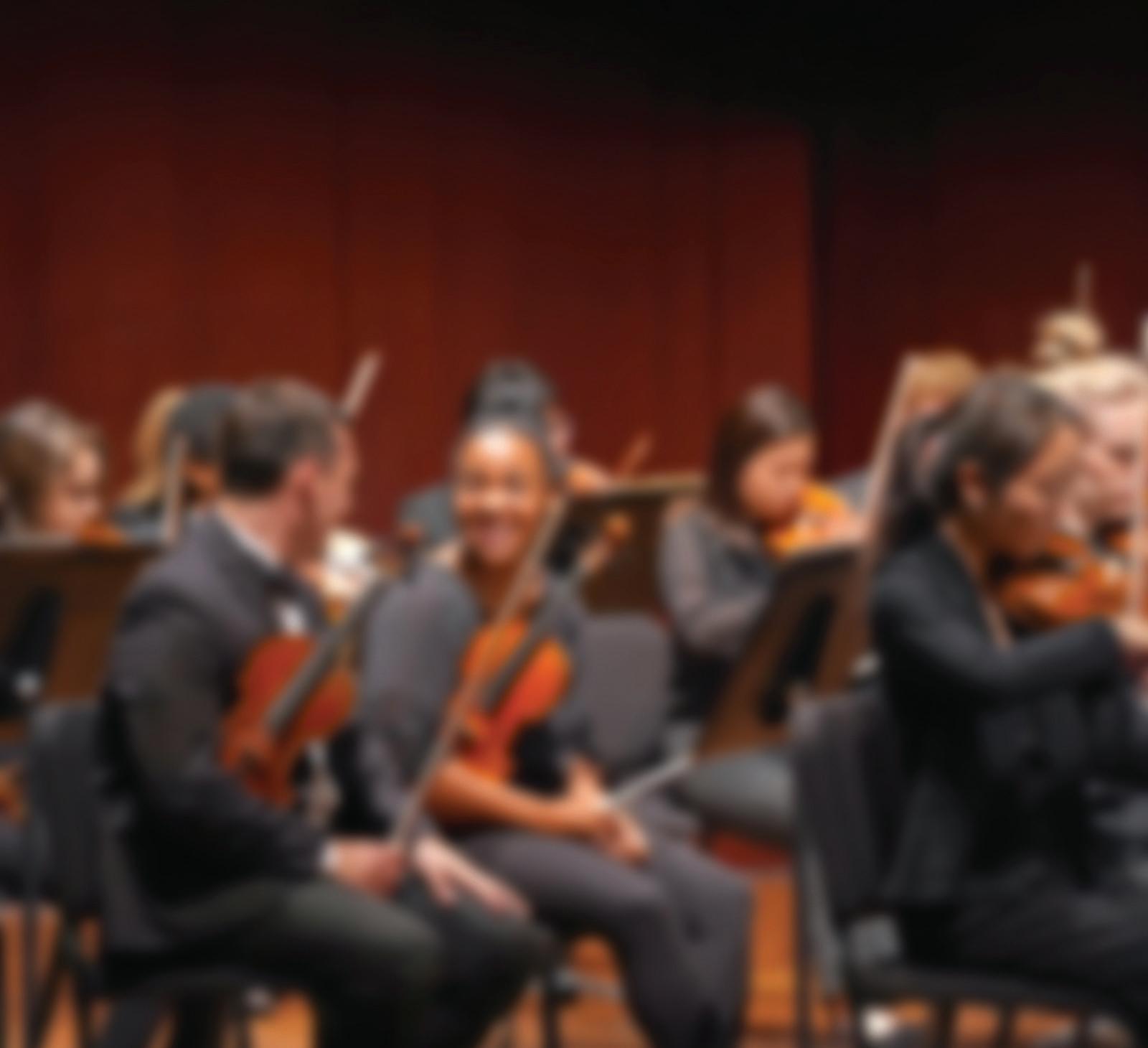
I chose broadcast journalism because I believe in the power of a human voice — its hesitation, its conviction and its ability to make people feel seen. Yet, in today’s media landscape, human creations are under threat. Art is replaced by algorithms that churn out images and scripts. Journalists are silenced by corporations that fire reporters for an X post. Opinions are reshaped by political pressure that dictates what stories can run. Creativity in media isn’t dying, it’s being suffocated.
What makes this moment in history different, however, is not just that jobs are disappearing or that speech is being policed. Those battles have always existed. It’s that both forces are converging at once, squeezing out the space for authentic storytelling. Artificial intelligence doesn’t just threaten paychecks, it flattens the human quirks and imperfections that give stories life. Censorship doesn’t just silence dissent, it creates a culture of fear where people stop taking risks altogether. These pressures are redefining what counts as creativity in the first place. Creativity in media is caught in a vice: technological innovation taking bounds from one side, power structures from the other, until the human voice — the very thing that makes stories resonate and art personal — struggles to be heard. Recently, I have found myself scrolling through TikTok and taking note of every trend that uses AI. Whether it’s a creator generating a photo of them and their favorite celebrity or posting an AI-generated cartoon of themselves in Charlie and Lola style, I’m often struck by how fast trends circulate and images appear. Some are so vivid that it takes a moment to realize they aren’t

real. This image generation goes beyond TikTok, though, and into Vogue, a publication that has utilized real models and photographers since its beginning in 1892. In July, Vogue’s AI-generated ad sparked outrage after readers discovered that a model included in the edition’s spread didn’t exist, but was rather a digitally designed composite trained on thousands of real women’s faces. This brought about fury from photographers, models and stylists whose livelihoods depend on human vision and creation. Forbes called it an “industry panic” that blurred the line between creative efficiency and creative theft.
Each generated image is built on a dataset of real human work: countless photos, paintings, sketches and faces scraped from the internet without consent. Artists have begun fighting back, hoping for compensation or “opt-out” tools that protect their creations, but the
legal boundaries become hazy. What prevents art with paid protection on one site from being stolen on other unprotected ones? Who owns an image made from thousands of unseen hands? What happens to the notion of art when its human origin is replaced by code?
Generative AI has swept into nearly every creative industry. Singers now find their voices mimicked by AI models that can reproduce pitch, tone and emotion with startling accuracy. Graphic designers and photographers will continue to see commissions dry up as clients realize they can generate an entire campaign in seconds for the price of a subscription. Even pop stars have stumbled into controversy: In August, fans criticized Sabrina Carpenter for releasing AI-generated stickers for her Man’s Best Friend merchandise line, calling it a betrayal of artistic integrity. It becomes a reminder that
even the most popular artists aren’t immune to crossing the line between innovation and imitation.
Furthermore, in Hollywood, AI threatens not just aesthetics but employment. Background actors — the most concealed workers on a film set but crucial for making films look authentic — are increasingly being scanned so studios can use digital replicas instead. During the SAG-AFTRA strike two years ago, in which Hollywood actors went on strike for four months demanding better pay and protection against AI, performers warned that these scans could become a permanent replacement for human presence on screen. The question was no longer whether machines can make art, but whether humans will still be paid for it. Another example that Hollywood is looking into is Tilly Norwood, a new actress made completely of AI. She appeared in mini-films that debuted on her Instagram
account, each of which presents her to the public as an aspiring actress. Although she hasn’t been in any large films yet, the idea of an AI actress taking on a lead when there are so many studied actors trying to get roles is concerning.
On one hand, AI has the potential to make programs more efficient, but on the other, it exemplifies how seamlessly AI can insert itself into human-centered spaces. When algorithms start shaping how we see, watch and read, creativity risks becoming another system optimized for output.
This shift extends to writing and journalism — professions built on nuance and accountability. Nexstar Media Group, one of the largest local TV station owners in the United States, recently announced plans to go “all in on agentic AI” to generate ads, automate news production and potentially replace on-air anchors with virtual ones. Their

AI-generated anchors are already in testing. The company claims this decision will boost efficiency, but critics say it signals the end of local storytelling — the kind that depends on trust built through human presence. When AI writes the news, context suffers. It can’t walk into a city council meeting and sense tension in a room. It can’t know when a quote feels dishonest or when a silence feels heavy. It doesn’t ask follow-up questions or pause out of empathy. Journalism, at its core, isn’t about producing information, but about interpreting humanity. No algorithm can replicate that. If technology is one of the hands squeezing creativity, corporate and political power is the other. In September, late-night host Jimmy Kimmel’s show was temporarily suspended after he criticized the late conservative commentator Charlie Kirk on air days after his death. Days later, President Donald Trump threatened to revoke broadcast licenses of networks he deemed anti-American and also claimed that critical television coverage of him is illegal. Trump, reflecting on what has been written about himself, claimed that when the majority of stories about a person are bad, it’s no longer free speech. It’s hard not to feel
stories that don’t match the views of the publications they write for. In an environment where employment depends on maintaining “neutrality,” honesty feels risky.
CONTINUED AT MICHIGANDAILY.COM
Revenge: Dare we take part? Do you want kids?
IRENA TUTUNARI Statement Deputy Editor
Let me preface this by saying that I was never someone who believed in the nefarious power of revenge. In fact, I was actually against it in every which way. I subscribed to the school of thought known as “karma,” certain that whoever coined the phrase “what goes around comes around” deserved some sort of Nobel Peace Prize. I mean, they must have single-handedly halted a lot of catty behavior and maintained at least a modicum of peace among high school girls and the likes. So yeah, I was a pretty big fan of turning the other cheek.
I now implore you to note my operative use of the past tense.
This whole being-the-biggerperson thing was fine and dandy for a while, but my raindrops-onroses outlook took a significant turn for the worse when I — like most naive 20-year-old girls who convince themselves “this is what love feels like, right?”— got cheated on. Hoping for a collective gasp here because that was pretty much my reaction too.
Anyone who’s been cheated on knows that it’s not just the betrayal and the idea of your partner with someone else (or in my case, multiple someone elses, hooray) that stings the most, but the shattered reality that cannot be pieced back together no matter how hard you try. You realize that for a month, two, three, you’ve unknowingly been living a lie. The shards of this will prick at you when you re-read seemingly innocuous old messages
and wonder, how could you have missed it, how could you have been so clueless? Where were the signs?
And not to hop on my soapbox, but if the one person you loved and trusted most in the world had not just the capacity but the intention to hurt you, what does that say about everyone else in your life? Naturally, my best friends were plotting to defecate on my most prized possessions, my acquaintances had serious intentions of abducting my miniature poodle and my coworkers were most certainly hawk-tuah-ing in my morning cup o’ joe while I had my back turned. OK. That’s enough of my scorned woman’s lament; kindly remove the tiny violins from between your fingers.
I spent the next few weeks post-infidelity-discovery in a fairly inconspicuous manner. To which I say, kudos to myself! My days consisted of the following schedule, in no particular order: I’d listen to Sam Smith on a loop, eat a few green grapes per day, create public Spotify playlists that I super coolly and casually titled “HOW COULD YOU?”, have weird and disjointed nightmares about my ex-boyfriend and some unidentifiable woman with horns and, of course, cry enough tears to water a small potted plant. Honestly, I believe I was pretty tame given the circumstances — mostly because my ex didn’t have a car, nor did I have a set of keys readily available, but I digress. Carrie Underwood should seriously speak at schools, by the way. Despite my general coolness and awesomeness throughout that whole “ordeal” (which doesn’t
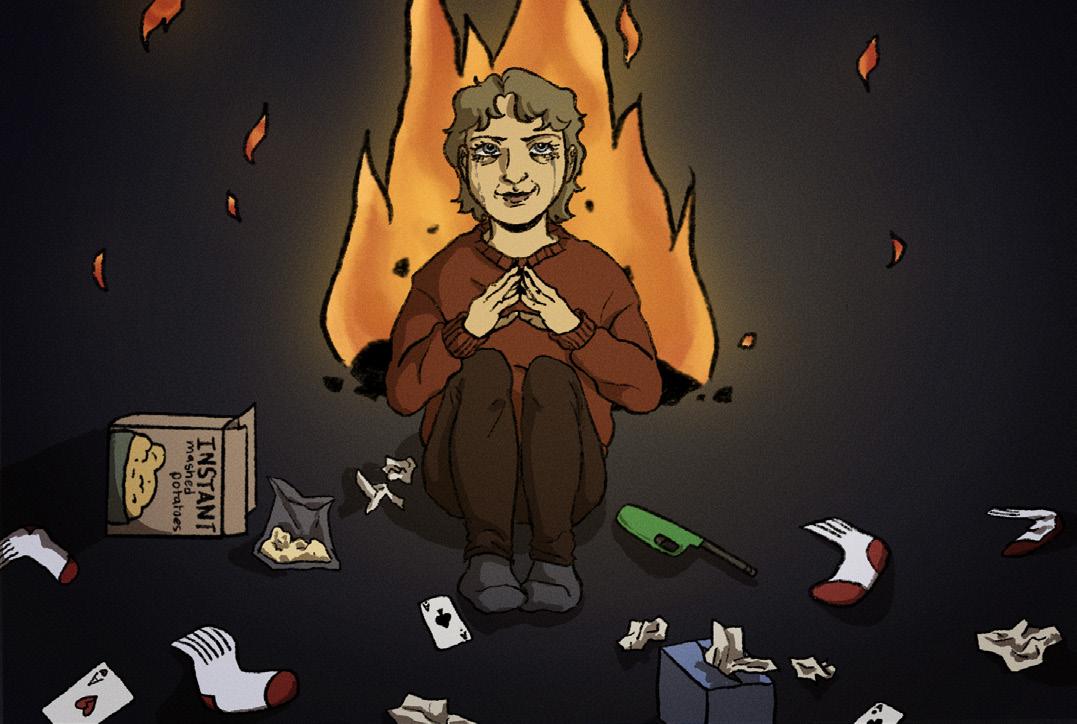
feel like a strong enough word), there were a few things I did that don’t completely fall within the parameters of “chill.” Twist my arm, what you’ve heard is true. I may have acquired myself a teensy weensy bit of revenge.
Now, before we point our fingers and call anyone “unethical” or something extreme (and perhaps warranted) like that, it’s important to note that I’m someone who truly does care about being employable in the future, so when my friend lovingly suggested that I urinate in my adulterous ex’s drugstore shampoo, I respectfully declined, much to their chagrin.
That has to earn me at least a pat on the back, right?
My intention was not to cause irreparable harm or even do something too noticeable. No, just something I could think back to and giggle about when the going got rough, which, shocker, it did. All valuable items were left intact in their respective locations, no instant mashed potatoes were poured on anyone’s lawn and I exited my ex’s apartment for the last time with my heart in pieces on the floor, but my head held high. Mostly in an attempt to make the tears fall back into my eyes. Which — don’t shoot the messenger — I found not to be possible.
I needed to take matters, at least minorly, into my own hands. Which were about to get a bit messy.
To avoid divulging too much, I will say that yes, I may have confiscated a good number of his socks to ensure he had no matching pairs. And okay, maybe I also rifled through his fancy deck of cards and removed three kings, three queens, three jacks and three aces so he never wins another card game again (who am I kidding, this man does not play cards, he just plays me). And for Pete’s sake, alright, yes, maybe I was the one who hiked the heat up in his apartment to 90 degrees on a hot summer day so he returned from the gym to a sneak peek of his inevitable vacation to hell. I’d say “free sauna!” but electricity bills don’t pay themselves. If it wasn’t already obvious, I think I’m a hoot. CONTINUED AT MICHIGANDAILY.COM
MEGHAN
DWAN Statement Correspondent
In my most indulgent dreams, I have a little, healthy baby in my arms. They grip my pinky finger with all their strength as their wide, familiar eyes gaze up at the world and take in every flicker of light and every cycle of shade through the window. They have a favorite color — because they are a completely new person, no one sees colors quite the same way as them. They have a favorite song that creates completely new images in their head, something never imagined before. They are guided by me, and I watch as they discover a new world, completely unique to their mind.
So my answer to the invasive question of “Do you want kids?” is “Yes, but … ,” because that choice is not completely up to me, nor truly within my control. Every woman seems to have a prophecy in her life, a “to-be-or-not-to-be” question she’s tasked with. One day, the question will sneak in quietly. Whether in a dimly lit room at a sleepover with friends or in an interview room for her first salaried job, the question will be asked at some point. And there’s incredible pressure to stick to one answer.
If you say no, people will insist your answer will change. If you say yes, they bring up the laundry list of tasks and ask how you will whittle your way through each item. What about your health? What about your financial means? Your career? Your body? Your time?
People seem to think this question of motherhood, at most, has a few layers with a core of yes or no. In their eyes, the layers stem from your answer. For me, it’s much more of a mottled, tangled nest with the possibility of my infertility lying at the center. My diagnosis of polycystic ovarian syndrome came as a surprise, mainly and exclusively because no one had ever spoken about PCOS to me before I was diagnosed. Despite how

common it is and how many people in my life have revealed themselves to have it, I had never heard of it before my diagnosis.
After reading the little summary pamphlet the doctor gave me through the MiChart portal, the pieces began to click into place.
Even as I tried not to be too upset about all of the things that might come with a chronic illness, it seemed like the possibility of infertility was the only symptom that stood out for me, and everyone else in my life. I didn’t entirely want it to be as big of a deal as it became. There are a lot of other unpleasant possibilities that come with PCOS, but no one really speaks about those. They are the lesser evil.
Even though I myself was upset about it, it was sort of demeaning to have it watered down to just one complication. Why was the possibility of not being able to conceive more important than the possibility of developing Type II Diabetes or heart disease?
The capability of creating new life should open a million doors. It should expand women’s creativity. It should give them new and undiscovered paths to map and shape. In reality, it can feel so limiting. In being such a wonderful power, it becomes a responsibility. Who else carries humanity in their stomachs, on just two feet? Its beauty is what makes the simplification so insulting.
Once women become mothers, it’s difficult to be much
else. Mothers are expected to risk their life in childbirth. Then, their bodies are altered permanently. There’s also the question of a career afterward and the question of childcare and schooling. Never mind the question of breastfeeding. The question of why they are crying. What will they eat? What do they need? What can they watch? What can’t they? Are they getting enough sleep? Enough attention? Enough nutrition? Enough activity? Are they reading enough? Playing enough? Do they get along with their siblings, with the dog, with other kids?
In all this worry, who has time to think of friends? Of extended family? Of their job? Of their needs?
I’m sure fathers go through similar questionings. However, they are seldom responsible for birthing a new life. Most women have to stack questions about their own health on top of anxieties about their child. Postpartum depression is one of many common health effects. The list is seemingly endless. It’s difficult to find certainty amid everything that’s at risk. Essentially, the hypothetical baby is placed over the actual living, breathing person who is answering the question of a potential maternal future. Even if I didn’t have PCOS, it would still be a health risk. Perhaps that’s why birth rates are declining in the U.S. CONTINUED AT MICHIGANDAILY.COM
People wouldn’t remember the hit. They would only remember what he said after.
Then-high schooler Derrick Moore would burst off the line with colossal force. Opposing offensive linemen dug their feet in, bracing for the inevitable impact, but there was no chance for them to hold their ground as he tore into the backfield. The hit was explosive and decisive, like Moore was made for it. And by the end of the play, he was there offering his hand to help them to their feet. Sure, they’d bark at him in frustration, but Moore only left them with three words: “God bless you.” Moore has never been a man of many words. A quiet kid from Baltimore, Md., he prefers to keep to himself, always listening before speaking. But when he does talk, the energy in the room shifts. Teammates lean forward in their chairs, shuffling ceases and everything goes still. When Moore speaks, people listen.
“He doesn’t need to raise his voice or always speak over or overshadow people,” Danaz Williams, Moore’s high school football coach, told The Michigan Daily. “It’s just his presence. It’s always known, and it’s done with a lot of discipline.”
The neighborhoods of Baltimore, the walls of Saint Frances Academy, the village that guided him — brick by brick, they built Moore. His leadership has never come from volume, but from presence and the people and places that shaped him. And when Moore finally speaks, it’s not just his voice. It’s the echo of every community that he carries with him. ***
Football wasn’t Moore’s first love. It wasn’t even his second. Those titles were already awarded to wrestling and basketball, respectively.
“I was like, ‘Oh my god, he’s going to grow up and be a damn sumo wrestler. We’re going to have a wrestler on our hands,’ which is fine,” Jakia Stewart, Moore’s mom, told The Daily. “Then, when he got into basketball, I was like, ‘I don’t know Derrick.’ He was okay. But I think he chose what was best for him in the end.”
Moore initially gravitated toward basketball because of his sheer size. As one of the bigger and younger kids in the pack, he played center and started to learn how to use his size to his advantage. His physicality, however, was more innate.
It turned out that Moore was too physical for his own good — at least on the court. He fouled out often. So when it came time for him to choose, the choice was easy: In football, he could hit people. In basketball, he couldn’t. From takedowns to rebounds to sacks, Moore’s focus has revolved around one thing: his why.
For Moore, it’s always been his mom. As the only child on that side of the family, Moore and his mother have an unbreakable bond. Her sacrifices stitched themselves into the fabric of he man he is today and the name he dons on the back of his jersey. For him, she’s the catalyst behind his passion for the game, each tackle, and every sack.
“Somebody asked me one time, ‘So when Derrick is famous, what is the one star you want to meet?’
” Stewart said. “I said, ‘Sweetie, I’ve been living with my star for 22 years.’ … When I wake up, and I hear, ‘Hey, Ma,’ that’s my star. I tell him all the time, ‘Man, you

make me look up to you.’ ”
That kind of presence, quiet yet gravitational, has become Moore’s hallmark.
***
When Moore first started playing at St. Frances, he perplexed both teammates and coaches alike. For how intimidating he appeared, he was exceptionally shy.
“He’s a gentle giant, that’s how we looked at him,” Williams said. “One of the biggest kids in the building, and you would never know, he’s always smiling. But on that football field, that light would just click, and you better not get in his way because he’s coming after the quarterback. … It was almost like Dr. Jekyll, Mr. Hyde.”
That dichotomy didn’t baffle his teammates.
Instead, it earned Moore their respect. The same teammate who plowed through opposing offensive lines without a second thought could also be found packing bags for food drives
Through the good and the unimaginable, it’s always been about the people for Michael Hage

the 21st overall pick of the draft, fulfilling his lifelong dream.
When a newborn Michael Hage came home from the hospital in April 2006, he was dressed in a mini Montreal Canadiens outfit courtesy of his father, Alain, a lifelong Habs fan. And when his younger brother, Alexander, was born nearly two years later, it was more of the same.
“I think if I had a little girl, she would have been in a pink Habs outfit,” Michael’s mother, Rania, told The Michigan Daily. “I don’t think our kids were given much of a choice. They’ve always watched hockey with their dad, and it was always the Habs.”
Eighteen years later, in June 2024, Michael, now a promising young hockey player, learned on the morning of the NHL Entry Draft that the Canadiens had traded up. A few short hours later, he donned the Habs’ red and blue once again, only this time, it was on the stage at the Las Vegas Sphere and his jersey wasn’t just a replica. His beloved Montreal Canadiens made him
Almost one year later, on March 25, Michael announced he would return for his sophomore season with the Michigan hockey team. In doing so, he delayed his debut for the team he’d cheered for since he was a baby by at least another year to play with the Wolverines.
“My plan was to come back all along,” Michael told The Daily. “These are the coolest moments of your life. You get to play hockey, and in front of a pretty electric crowd every night with your best friends that you go to school with. You’re with these guys 24/7, so there’s no one I’d rather be able to have another chance to win with than these guys.”
While Michael has multiple reasons for choosing to stay another year, from bettering his overall game to seeking an NCAA Championship, the biggest factor motivating him is the same one that’s been guiding him his entire hockey career — the people he’s doing it with, and the bonds he’s built with them.
*** The Hage family home where Michael grew up in Mississauga, Ontario bustled with activity.
Michael’s friends frequently came over, filling the house with laughter and good-natured banter. Though Michael has been described by friends and family as shy and reserved at first, he was already developing a penchant for witty repartee that he’d carry over into his hockey career, dishing out jabs as well as he could take them.
Even something as routine as a summer appointment with a physiotherapist turned into a lively evening. Michael and a few of his young teammates would spend the entire session trying to embarrass each other, sending the house into fits of laughter.
The same playful back-andforth he shared with his friends characterized his relationship with Alexander, as everything from climbing up the stairs to throwing a ball around turned into competition between the brothers.
CONTINUED AT MICHIGANDAILY.COM
and helping Williams feed the homeless on Thanksgiving. Because at the end of the day, Moore never lost sight of what mattered most.
Throughout his childhood and time at St. Frances, Moore had a village — people who saw something in him that he didn’t quite yet see in himself. They pushed him to keep his head down, work hard and stay focused on the field. And it was there that his insatiable drive to succeed collided with the sweat, silence and progress that came with each repetition, forming the framework upon which Moore’s dream became tangible.
“It’s a love for him,” Stewart said. “He loves the sport, even to this day. How he gets up and he just goes, he goes to school, he goes to workout, he goes to practice. And he never complained.”
That rigid discipline and passion eventually culminated in a call, a call from an old head coach
from St. Frances — Michigan’s current associate head coach Biff Poggi.
“Making it to college was my proud moment,” Moore told The Daily. “Being a person from where I’m from, there’s not too many people that make it out and get to live their dreams. So I feel like making it to college was really one of my proud moments. Also, being able to be the face of one of the programs, and showing the youth that, like, ‘I was in your shoes once, and now look where I’m at.’ ”
After decommitting from Oklahoma when coach Lincoln Riley left the program, Poggi called Moore and asked him to visit Michigan. Poggi believed that once Moore visited, he was going to realize that Michigan felt like home. And it did. Because at Michigan, Moore found exactly what he’d been craving from home: a brotherhood.
By the time Moore hung up his high school jersey and his cleats,
he had become far more than just a decorated four-star recruit. He had become a leader, one whose presence commanded attention without demanding it.
A man shaped by the neighborhoods, classrooms and football fields that raised him, each of Moore’s actions is a reflection of the communities that poured into him and a promise of the legacy he will carry forward.
*** Two weeks into this season, Moore, graduate tight end Max Bredeson and the rest of Michigan’s captains were preparing for their playerled meeting. Michigan coach Sherrone Moore had just left to serve his self-imposed two-game suspension, and Poggi, along with the rest of the coaching staff, had decided that the players were going to lead this team during the suspension.
CONTINUED AT MICHIGANDAILY.COM
Sophie Matthews: Michigan’s aggressive recruitment through the CHL will revitalize the program

the NCAA. This change came at just the right time for Michigan to shake up its approach. Naurato’s new strategy to target CHL stars should see the Wolverines producing results more similar to what they’re used to.
Last season, Michigan put trust into players that had plenty of skill, but not enough experience. This time around, the Wolverines have not fallen for that trap. Despite 14 new additions to the team — 11 being freshmen — Michigan sought out players with experience competing at a higher level.
went against the trend. And that aggressive recruiting style is going to greatly increase the depth of his squad.
After riding a five-year long rollercoaster that appeared to have more peaks than valleys, the Michigan hockey team finally hit the bottom of the track at the end of last season.
With a disappointing conclusion to the 2024-25 season after conceding two losses to Penn State in the first round of the Big Ten Tournament, the Wolverines ended their three-year streak of Frozen Four appearances by failing to even qualify for the NCAA Championship. This prompted a state of emergency for the program that now needs to rediscover its winning ways through new roster construction.
But Michigan coach Brandon Naurato is determined to not let his program slip away.
“Tell you what,” Naurato said March 8th after loss to the Nittany Lions. “Michigan will never be in this spot again, ever, ever, ever as long as I’m here.”
College hockey is going through a series of changes, entering uncharted territory with players in the Canadian Hockey League now allowed to make the jump to
The CHL has been around for much less time than the NCAA, but it took player development by storm.
With 68 regular-season games, starting at the age of 16, players are put in against opponents as many as four years older than them.
They learn how to hit, skate and think like those who have years of experience. Due to the professional nature of this league, especially with the compensation players receive, the NCAA initially barred CHL athletes from participating at the collegiate level.
This kept much of North America’s young hockey talent separate, as top Canadian prospects had to choose between the CHL and NCAA. And due to its successful track record in player development, the CHL has always attracted much of the top talent. But in November, the two leagues came to an agreement to allow for the CHL’s participation in the NCAA.
The Wolverines took complete advantage of this growth in the player pool, adding four players from the CHL to their long list of freshmen recruits. While most teams added one or two of these athletes to their roster, Naurato
Michigan may not have landed the most high-profile recruits like Penn State forward Gavin McKenna or Michigan State forward Porter Martone, but that hasn’t stopped it from being named Neutral Zone’s top recruitment class for 2025. The Wolverines excelled in addressing areas of concern after last season and finding talented, experienced players to aid those weak points. In the crease, much excitement has surrounded Nashville Predators prospect Jack Ivankovic’s commitment, who is coming from the Brampton Steelheads of the Ontario Hockey League, one of three leagues under the umbrella of the CHL. In the previous season, there was the constant question of which goalie would start in net. Naurato had to find a goalie where he could put his full faith in their performance if he were to have the defense stray from a conservative style. The team will have the ability to try a more attack-based play — and hopefully converting more goals — with the freshman in net.
Michigan’s defense is also getting a facelift with the addition of not only one, but two freshmen defenders from the OHL. Matthew Mania of the Flint Firebirds and Henry Mews of the Sudbury Wolves are two of the pieces Naurato target to fill the loss of veteran defenders. The Wolverines have emphasized the need for experienced players, and these two athletes, in spite of their freshmen standing, developed a unique skillset in the OHL that will bode well for Michigan’s blue line.




3 MONTHS FREE
